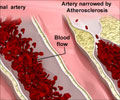The widespread adoption of the use of drug-releasing coronary artery stents into routine practice is associated with a decrease in the need for repeat procedures to unblock coronary arteries.
The widespread adoption of the use of drug-releasing coronary artery stents into routine practice is associated with a decrease in the need for repeat procedures to unblock coronary arteries and also do not appear to increase the risk of death, //compared to bare-metal stents, according to a study in the June 25 issue of JAMA.
“There has been a growing concern about the possibility of an increased risk of stent thrombosis (ST; formation of a clot in a blood vessel) associated with the use of drug-eluting [releasing] stents compared with bare-metal stents. Although a relatively rare event, stent thrombosis is associated with a high risk of myocardial infarction (MI; heart attack) and death and any suggestion of possible excess risk has justifiably been the focus of intense investigation,” the authors write. Despite several recent studies, there remains uncertainty about the trade-offs between the safety and effectiveness of drug-eluting stents.David J. Malenka, M.D., of Dartmouth-Hitchcock Medical Center, Lebanon, N.H., and colleagues performed a study to compare the rates of revascularization (repeat procedure to unblock a coronary artery), heart attack and survival, before and after the availability of drug-eluting stents. The study included 38,917 Medicare patients who underwent non-emergency coronary stenting from October 2002 through March 2003 when only bare-metal stents were available and 28,086 similar patients who underwent coronary stenting from September through December 2003, when 61.5 percent of patients received a drug-eluting stent and 38.5 percent received a bare-metal stent. Follow-up data were available through December 2005.
During the 2 years of observation, 22.8 percent of patients in the bare-metal stent era group underwent a repeat revascularization (20.0 percent, percutaneous coronary intervention [PCI; procedures such as balloon angioplasty or stent placement used to open narrowed coronary arteries]; 4.2 percent, coronary artery bypass graft [CABG]). In the drug-eluting stent era group, 19.0 percent of patients underwent a repeat revascularization (17.1 percent PCI; 2.7 percent CABG). The risk of repeat revascularization decreased by approximately 18 percent in the drug-eluting stent era compared with the bare-metal stent era.
There was no difference in unadjusted mortality risks at 2 years (8.4 percent vs. 8.4 percent), but a small decrease in ST-elevation myocardial infarction (STEMI; a certain pattern on an electrocardiogram following a heart attack) existed (2.4 percent vs. 2.0 percent). The adjusted risk of death or STEMI at 2 years was similar.
“Although such an analysis will not answer the question of what is the true rate of stent thrombosis with drug-eluting stent vs. the rate with bare-metal stent, it does address the important question of whether, on-average, the population of stented patients is being helped or hurt by the widespread use of this technology,” the authors write.
“Although other data may suggest some incremental risk of stent thrombosis with the use of drug-eluting stents, we can detect no adverse consequence to the health of the population. We speculate that whatever the increased risk of stent thrombosis associated with drug-eluting stent use is, it is more than offset by a decrease in the risk of developing restenosis [renarrowing of a coronary artery after angioplasty] and the attendant risk of a procedure to treat that restenosis.”
Advertisement
Source-ANI
SPH
Advertisement
SPH







